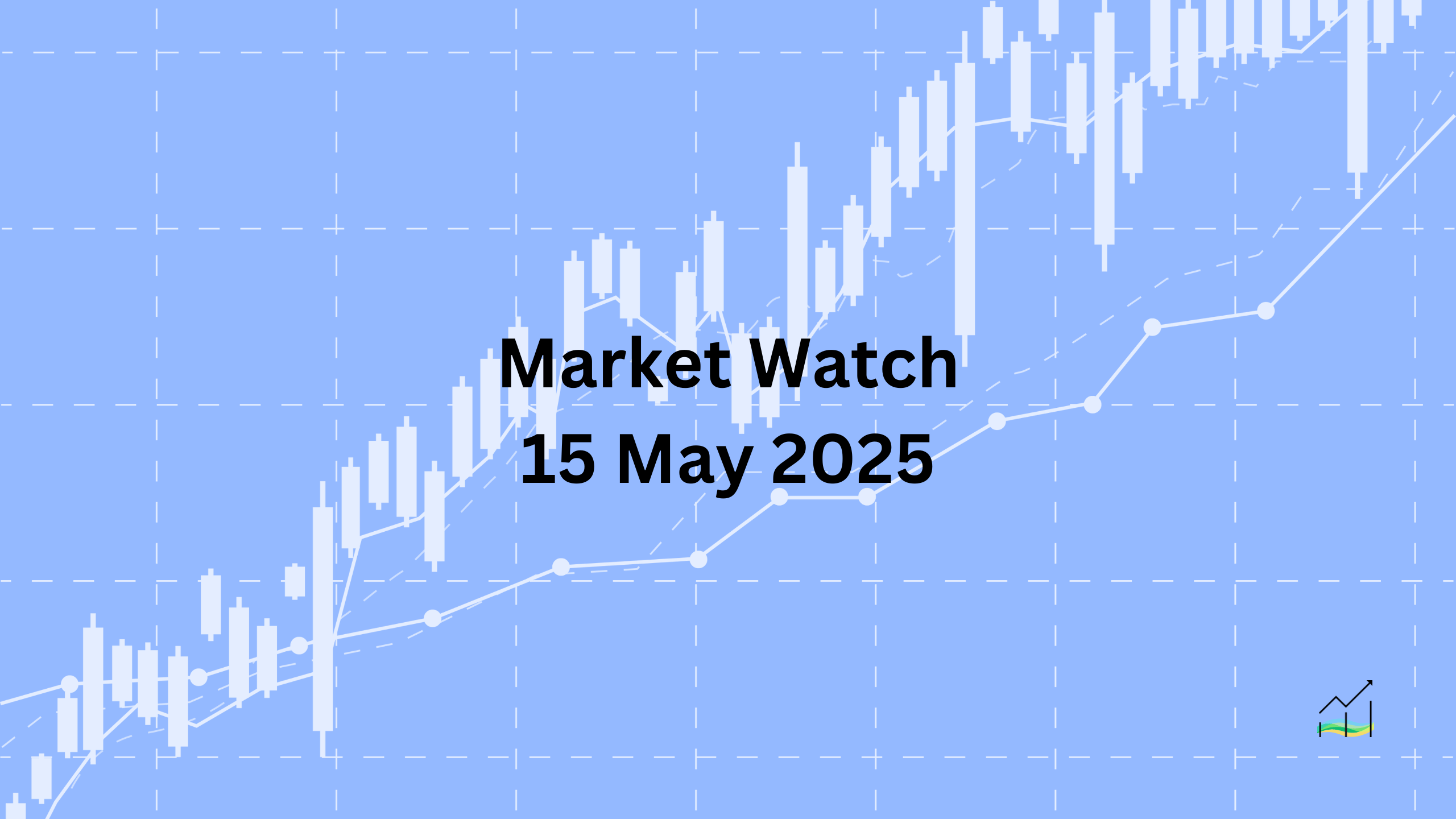15/05/2025 Market Watch

Dollar Rally Pauses as Markets React to Potential Iran Deal
Key Takeaways:
- The US dollar's recent strength has waned slightly; softer against most G10 currencies.
- Swiss franc and Japanese yen outperforming among G10 currencies, supported by strong Swiss GDP data.
- Emerging market currencies mostly stronger except for China and Russia.
- Equities under pressure: losses in major Asian and European markets, US futures lower.
- Treasury and European bond yields modestly lower.
- Gold hits lowest since April before slight recovery; oil sharply lower on potential Iran deal.
The US dollar's recent upward momentum has moderated today, as the greenback softened against most G10 currencies following yesterday’s gains. Although dollar buying emerged in North American trading previously, the sentiment has since cooled, leaving the currency generally weaker in today’s trading session.
Among the standout currencies, the Swiss franc emerged as the strongest performer within the G10 space, driven by a stronger-than-expected Swiss first-quarter GDP report. The Japanese yen closely followed, gaining traction amid cautious sentiment across global markets. In contrast, commodity-linked currencies, notably the Australian and New Zealand dollars, faced headwinds partly due to a sharp downturn in oil prices. This decline was triggered by news of a possible deal between the US and Iran, suggested by comments from former President Trump, weighing heavily on energy prices.
Emerging market currencies broadly advanced, although notable exceptions included the Chinese yuan and Russian ruble, both weaker in today’s trading session.
Equities experienced broad-based weakness, with key markets across Asia and Europe facing declines. Japan’s Topix index witnessed continued profit-taking after recently breaking a 13-day winning streak. European markets also struggled, with the Stoxx 600 index declining for the second consecutive day, signaling a cautious investor outlook. US equity futures mirrored this sentiment, with both the S&P 500 and Nasdaq futures indicating losses of just over 0.5%.
In the bond markets, European 10-year yields are marginally lower, reflecting the cautious risk environment. US 10-year Treasury yields similarly eased by around three basis points, currently hovering near 4.50%.
Gold prices extended losses to their lowest level since early April, reaching approximately $3120 per ounce. Although prices subsequently bounced back toward the $3177 mark, analysts suggest a recovery beyond $3200 is necessary to stabilize market sentiment. Meanwhile, oil prices experienced significant declines, with June WTI crude dropping sharply to around $60.50 per barrel due to renewed prospects of increased Iranian oil supply. Traders are eyeing the next technical support near $59.60, which could offer temporary stability if tested.
United States of America
Overview
The US dollar experienced notable volatility yesterday. Initially, the Dollar Index (DXY) slipped to a three-day low around 100.25 during European trading but rebounded strongly during the North American session, reaching close to 101.15. This created a potential bullish hammer candlestick pattern on daily charts, suggesting possible strength ahead. However, follow-through buying today has been minimal, with DXY stalling near 101.00 before easing back to approximately 100.60.
Today's market focus will be on an extensive series of economic data releases from the US, providing insights across various segments of the economy. These reports include regional manufacturing surveys, retail sales, industrial production figures, producer prices, and business inventories. Notably, there's divergence in expectations for retail sales, with Bloomberg’s consensus anticipating modest growth, contrasting with the Chicago Fed's more cautious projection.
Additionally, geopolitical dynamics remain influential, especially following the delay of harsh tariff implementations between the US and China. This development has led analysts to reduce their perceived risk of a US recession while improving their outlook on China's economic growth. Meanwhile, Federal Reserve Chair Jerome Powell will address the central bank’s policy framework today, though his remarks are expected to be carefully measured and unlikely to delve into sensitive political matters.
Economic Drivers
- Volatile US dollar sentiment amid mixed economic signals.
- Potential easing in US-China trade tensions, reducing recession fears.
- Expectations of moderate economic growth in Q2, supported by the Atlanta Fed GDP Now model forecasting 2.3%.
- Divergent outlook on retail sales figures signaling consumer spending uncertainty.
Data and Events
- May 15, 2025: NY Fed Manufacturing Survey.
- May 15, 2025: Philadelphia Fed Manufacturing Survey.
- May 15, 2025: US Retail Sales.
- May 15, 2025: US Industrial Production.
- May 15, 2025: US Producer Price Index (PPI).
- May 15, 2025: March Business Inventories.
- May 15, 2025: Fed Chair Powell Speech on Policy Framework.
Price Action
- Dollar Index rebounded from trendline support near 99.90, indicating strong technical buying interest.
- Lack of sustained follow-through today after yesterday’s bullish hammer pattern; resistance near 101.00 remains a short-term cap.
- Critical support levels around 99.90 (50% retracement level) remain intact.
Key Points:
- Dollar volatility continues, short-term bullish signals evident but limited follow-through today.
- Focus on diverse economic data today to clarify near-term outlook.
- US-China trade developments improve sentiment but uncertainty remains.
- Technical support around 99.90 remains pivotal.
Australia
Overview
The Australian dollar experienced a brief push above $0.6500 yesterday but quickly reversed, unable to sustain momentum and falling towards the $0.6420 region during North American trading. Despite unexpectedly strong domestic employment data, the Aussie dollar has struggled today, drifting slightly lower to around $0.6415.
Australia’s employment data significantly exceeded expectations, showing an impressive gain of 89,000 jobs in April, over three times higher than anticipated. Notably, the bulk of these jobs were full-time positions, which highlights robust labor market conditions. Additionally, the unemployment rate remained stable between 4.1% and 4.2% for the fifth straight month, a remarkable feat considering the increase in the participation rate to a three-month high of 67.1%.
However, despite these robust employment figures, market sentiment remains cautious toward the Australian economy. Investors widely expect the Reserve Bank of Australia (RBA) to proceed with an interest rate cut in its upcoming policy meeting and anticipate two additional cuts before year-end, reflecting ongoing economic uncertainties.
Economic Drivers
- Strong employment growth and a steady unemployment rate indicating resilience in the labor market.
- Rising participation rate showing increased workforce engagement.
- Persistent market expectations of RBA rate cuts reflecting underlying economic concerns.
- Global sentiment weighed down by uncertainties related to economic growth and commodity price movements.
Data and Events
- May 15, 2025: Employment Change.
- May 15, 2025: Unemployment Change.
Price Action
- The Australian dollar reversed sharply after failing to sustain above $0.6500.
- Immediate downside risk below the current support at the $0.6400-$0.6410 area.
- Next significant support at this week's low in the $0.6355-$0.6360 region.
Key Points:
- Australian dollar retreats despite robust employment data.
- Market anticipates multiple RBA rate cuts this year.
- Critical near-term support levels at $0.6400 and further down at $0.6355.
Europe
Overview
The euro exhibited significant volatility yesterday, initially strengthening to a three-day peak near $1.1265 during European trading before sharply retreating to approximately $1.1165 in the North American session. Today's price action shows some stabilization, as the currency managed to hold above yesterday’s lows and regained some ground, climbing back to around $1.1230.
On the economic front, revised data showed the Eurozone's economy grew slightly less than initially reported in the first quarter, with GDP adjusted downward to 0.3% from the previously reported 0.4%. Nevertheless, industrial output provided positive news, surging by 2.6%, significantly outperforming market expectations. This marked the first back-to-back increase of more than 1% since mid-2022, indicating strengthening industrial momentum across the region.
Despite this generally positive economic news, traders remain cautious about the euro's direction given ongoing uncertainties and recent price fluctuations.
Economic Drivers
- Revised Eurozone GDP indicates slightly slower economic growth.
- Significant rebound in industrial production, suggesting resilience in the manufacturing sector.
- Persistent market caution amid broader global economic uncertainty.
Data and Events
- May 15, 2025: Flash GDP.
- May 15, 2025: Industrial Production.
Price Action
- Euro retreated sharply after reaching key retracement resistance near $1.1265.
- Support at yesterday's low around $1.1165 is holding, suggesting near-term stability.
- Resistance remains around the recent high at $1.1265, with further upside potential requiring a decisive breakout.
Key Points:
- Euro fluctuates, stabilizing after sharp moves yesterday.
- Mixed economic signals: GDP slightly weaker, but strong industrial production.
- Immediate technical support and resistance clearly defined at $1.1165 and $1.1265, respectively.
Japan
Overview
The dollar-yen pair exhibited notable volatility yesterday, fluctuating within an extensive two-yen range. After briefly dipping below JPY145.70 during European trading, the pair recovered above JPY147 by the early North American session. Ultimately, it settled around JPY146.75, though today's trading has seen renewed yen strength, pushing the pair back towards JPY145.50. Market sentiment remains cautious, with a sustained move above JPY146.30 necessary to stabilize the outlook.
Japan is set to release its initial GDP data for the first quarter this Friday, with expectations pointing towards a slight contraction. Analysts anticipate that weak public spending, declining private investment, and unfavorable net exports likely weighed on economic growth, despite potential support from consumer spending and inventory accumulation.
Further illustrating ongoing economic challenges, Nissan has announced substantial corporate restructuring measures. Following weak earnings, the automaker plans to shut down seven factories globally and lay off approximately 20,000 employees, significantly exceeding its previous estimates. This highlights broader concerns regarding Japan’s industrial and economic health amid persistent global economic uncertainty.
Economic Drivers
- Weak economic expectations for Q1 GDP due to reduced public consumption, private investment, and negative trade balance.
- Consumer spending and inventory levels potentially cushioning the economy.
- Major corporate restructuring (Nissan) highlighting vulnerability in Japan’s manufacturing sector.
- Persistent global economic uncertainty influencing market sentiment.
Data and Events
- May 16, 2025: Japan Q1 GDP (Preliminary)
Price Action
- USD/JPY faces significant volatility, trading in a broad range between JPY145.50 and JPY147.
- Key resistance observed around JPY146.30, with a clear break necessary to ease downside pressure.
- Immediate support at the recent low of approximately JPY145.50.
Key Points:
- Yen volatility remains elevated amid cautious sentiment.
- Upcoming GDP data likely to indicate slight economic contraction.
- Nissan's factory closures and large-scale layoffs underscore underlying economic pressures.
- Technical focus remains on key levels at JPY146.30 (resistance) and JPY145.50 (support).
United Kingdom
Overview
The British pound experienced notable volatility yesterday, initially climbing to a five-day high of around $1.3360 before retreating sharply during the North American session, eventually dropping to about $1.3255. Today's trading session has seen the pound consolidate within a narrower range between $1.3260 and $1.3305.
Economic data released for the first quarter revealed that the UK economy grew by 0.7%, slightly surpassing both market expectations and the Bank of England's forecasts. Within the GDP breakdown, household consumption increased modestly by 0.2%, an improvement from the previous quarter, though still below expectations. However, total business investment showed surprising resilience, surging by 5.9%, marking a significant turnaround from the previous quarter's decline.
Conversely, government expenditure unexpectedly contracted by 0.5%, diverging notably from forecasts of continued expansion. Monthly GDP figures for March showed moderate growth of 0.2%, despite a notable decline in industrial and manufacturing sectors, offset by gains in services and construction. Additionally, the UK's trade deficit narrowed during this period, reflecting improved trade dynamics.
Economic Drivers
- Better-than-expected Q1 GDP growth highlights economic resilience.
- Robust increase in business investment signals improved corporate confidence.
- Unexpected contraction in government spending reflects tighter fiscal policy.
- Persistent weakness in industrial and manufacturing sectors remains a concern.
- Services and construction sectors showing continued positive momentum.
- Narrowing of trade deficit indicates stronger external trade position.
Data and Events
- May 15, 2025: GDP Monthly.
- May 15, 2025: Prelim GDP Quarterly.
Price Action
- Sterling retreated sharply after failing to sustain gains above $1.3360.
- Currently consolidating in the $1.3260–$1.3305 range.
- Immediate technical support at around $1.3255; resistance remains at $1.3360.
Key Points:
- Pound volatile amid mixed economic signals.
- Positive Q1 GDP growth driven by strong business investment.
- Weakness in government spending and industrial output dampens outlook.
- Technical range-bound trading continues between $1.3255 and $1.3360.
© 2025 SKONE Enterprise (003319453-V). All rights reserved.
The content on this site is for informational purposes only and does not constitute financial advice.


